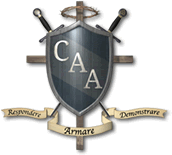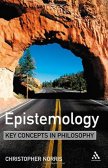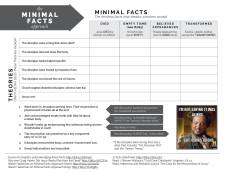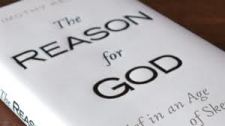I also recommend googling for “Tim McGrew Apologetics 315” as he has some great lectures on these topics.
The historical evidence for Jesus falls into three categories: non-Christian, historic Christian, and syncretistic (hybrid of previous two). It is “prejudicial to exclude automatically all Christian evidence…or to assume that all non-Christian evidence was necessarily more ‘objective.’ But even using only such non-Christian sources, there is ample evidence to confirm the main contours of the early Christian claims: Jesus was a Jew who lived in Israel during the first third of the first century; was born out of wedlock; intersected with the life and ministry of John the Baptist; attracted great crowds, especially because of his wondrous deeds; had a group of particularly close followers called disciples (five of whom are named); ran afoul of the Jewish religious authorities because of his controversial teachings sometimes deemed heretical or blasphemous; was crucified during the time of Pontius Pilate’s governorship of Judea (A.D. 26-36), and yet was believed by many of his followers to have been the Messiah, the anticipated liberator of Israel. His followers, therefore, continued consistently to grow in numbers, gathering together regularly for worship and instruction and even singing hymns to him as if he were a god (or God)” (p. 439-440, Groothuis).
So many websites claim Jesus never existed, but those who have actually investigated the issue are “virtually unanimous today in rejecting this view, regardless of their theological or ideological perspectives” (p.439, Groothuis). For example, see Bart Ehrman’s “Did Jesus Exist?”
Non-Christian Evidence
Objection: We have a sparse amount of information about the historical person of Jesus from non-Christians.
Answer:
1. History and biography focused on royalty, military action, and the wealthy
2. Non-Christians had no reason to predict Jesus’ spreading influence, and so it is remarkable that as much has been preserved outside Christian circles
3. Most ancient docs have been lost (including secular)
* “A dozen or more references to Jesus appear in non-Christian Jewish, Greek and Roman sources in the earliest centuries of the Common Era.” (ibid) [Jewish historian Josephus, several different portions of the Talmud (rabbinic traditions); Greek writers Lucian of Samosata, Mara bar Serapion; Roman historians Thallus, Tacitus, Pliny and Suetonius.]
** “Tacitus, for example, in the early second century, writes about Nero’s persecution of Christians and then explains, “The founder of this name, Christ, had been executed in the reign of Tiberius by the procurator Pontius Pilate” (Annals 44.3). The Talmud repeatedly acknowledges that Jesus worked miracles but refers to him as one who ‘practiced magic and led Israel astray’ (Babylonian Talmud Sanhedrin43a, cf. Tosefta Shabbath 11.15; Babylonian Talmud Shabbath104b). Josephus, in the late first century, calls Jesus ‘a wise man,’ ‘a worker of amazing deeds,’ ‘a teacher’ and ‘one accused by the leading men among us [who] condemned him to the cross’ (Antiquities of the Jews 18.3.3).” (ibid)
Christian Evidence
The four Gospels give us the most, and most important, information about Jesus, but they are not the earliest documents. Paul’s letters (probably started in the 40s) were written by the 50s and came before the Gospels, which were not written before the 60s.
The Apostle Paul
Paul’s letters show he had a good knowledge of Jesus in 3 ways:
1. “Paul clearly knows the basic outline of Jesus’ life. ‘What Paul appears to know about Jesus is that he was born as a human (Rom. 9.5) to a woman and under the law, that is, as a Jew (Gal. 4.4), that he was descended from David’s line (Rom. 1.3; 15:12) though he was not like Adam (Rom. 5.15), that he had brothers, including one named James (1 Cor. 9.5; Gal. 1:19), that he had a meal on the night he was betrayed (1 Cor. 1:23-25), that he was crucified and died on a cross (Phil. 2:8; 1 Cor. 1:23; 8.11; 15.3; Rom. 4:25; 5.6, 8; 1 Thess. 2.15; 4.14, etc.), was buried (1 Cor. 15.4), and was raised three days later (1 Cor. 15.4; Rom. 4:25; 8.34; 1 Thess. 4.14, etc.), and that afterwards he was seen by Peter, the disciples and others (1 Cor. 15:5-7)’” (p.442, ibid).
2. He knows very specific, wide range of Jesus’ teachings. Not exhaustive:
There are 5 factors supporting the probability that the Synoptics are historically accurate about Jesus:
-STROBEL: Acts stops before Paul’s death, so before 62 A.D. Luke even earlier. Mark even earlier than that.
-STROBEL: Mark and Luke not even among the Twelve.
2. Literary genre: Historical. Luke’s prologue similar to serious histories of that time (Josephus and the Greeks: Herodotus, Thucydides, Polybius, Lucian; Greco-Roman ‘technical prose’ or ‘scientific literature’). Luke 1:1-4.
3. Authorial intent (STROBEL: Luke 1:1-4; John 20:31). Jewish tradition and the NT gives careful attribution of prophetic words to the prophet who uttered them.
-STROBEL: Objection: We can’t tell where Jesus begins and where the Christian prophets end. Answer: Always distinguished between Jesus and a prophet, and always tested a prophet and made sure their words cohered with Jesus’ (1 Cor 7, 14).
4. Compositional procedures. Jews were memorization ARTISTS. Informal controlled oral tradition at work (and perhaps an alternative of the source Quelle, or Q—the hypothetical document Matthew and Luke may have relied upon).
-Explains similarities, and STROBEL: why Matthew would rely on Mark, recording the eyewitness testimony of Peter.
5. Apparent contradictions involve predictable, natural variations in story telling, like inclusion or omission of certain details determined by differing emphases.
-2. Matthew 8:5-9 centurion ask? Luke 7:1-8 friends ask? Both; friends represent him.
-4. Mark 16.5 young man? Matt 28:2-3 angel? Luke 24:4 two men? Angels are called men as well. One man/angel is one of two.
-5. Mark 2.26 Abiathar? 1 Sam 21:1-6 Ahimelech? epi “in the passage” Abiathar, not at the time of Abiathar—ancient Judaism had several chapters in a passage, divided according to how much was read each week
STROBEL: Objection 1: What about Mark and Luke saying that Jesus sent the demons into the swine at Gerasa, while Matthew says it was in Gadara? Gerasa isn’t even near the Sea of Galilee. Answer: Khersa (in Hebrew sounding like Gerasa) has been excavated at the right point on the eastern shore of the Sea of Galilee. Gerasa is in the province of Gadara. Objection 2: What about the discrepancies between the genealogies of Jesus in Matthew and Luke? Answer: Option 1: Matthew reflects Joseph’s lineage, Luke reflects Mary’s, and they converge at a common blood ancestor. Option 2: Luke reflects Joseph’s human lineage, Matthew reflects Joseph’s legal lineage, and they diverge when someone did not have direct offspring, but raised up heirs through an OT legal practice. Also: Some names are omitted (acceptable in the ancient world) and there are textual variants that result in confusing a name for a different individual.
1. More passages in John than not find no parallel in any Synoptic Gospel.
-Exorcisms: Viewed more as ‘magic’ in Greco-Roman world. (ibid)
-Kingdom: Replaced by eternal life, used interchangeably by Matthew (19:16, 23-24). (ibid)
-Statements were ambiguous and figurative (John 16:29) (p.461).
-Synoptics also represent high Christology in virgin birth and “I am” language (even in Mark 6:50 or 14:62). (ibid) STROBEL: Son of Man (Dan 7:13-14).
“Interlocking” of John with the Synoptics (“undesigned coincidences“)
1. “John 3:24 refers in passing to the Baptist’s imprisonment, but only the Synoptists ever narrate that event (Mark 4:14-29 and parallels).” (458, ibid)
2. “John knows Jesus was tried before the high priest Caiaphas (John 18:24, 28), but only the Synoptics describe this trial’s proceedings or its outcome (Mark 14:57-58).” (ibid)
3. “But nothing elsewhere in their narratives prepares the reader for this charge. John 2:19, on the other hand, includes Jesus’ allegation that if the Jewish leaders destroyed ‘this temple,’ he would rebuild it in three days, but it goes on to explain that he was speaking of the temple of his body, that is, an allusion to his death and resurrection. This, however, is a saying that could easily be twisted into what the Synoptics claim the false witnesses declared.” (ibid)
4. “Why did the Jewish leaders enlist the help of the Roman governor Pilate (Mark 15:1-3 and parallels), when their law was clear enough in prescribing the death penalty—by stoning—for blasphemers? Only John gives us the answer: under Roman occupation the Jews were forbidden from carrying out this portion of their law (John 18:31).” (ibid)
2. “John 2 begins with the remarkable miracle of turning water into wine, yet it coheres perfectly with the little parable, regularly viewed as authentic, of new wine (Jesus’ kingdom teaching) needing new wineskins (new religious forms).
3. John 2 highlights Jesus’ conversation with Nicodemus, a rare Jewish name that appears repeatedly in the rabbinic literature about the wealthy, powerful, Pharisaic ben-Gurion family.
4. The story of Jesus’ surprising solicitousness for the Samaritan woman in John 4 coheres closely with his compassion for outcasts throughout the Synoptics.
5. The distinctive synagogue homily in John 6 on Jesus as the bread of life matches perfectly with a standard rabbinical exegetical form known as a proem midrash.
6. Jesus’ claims at the Festival of Tabernacles to be living water and the light of the world (in John 7-9) fit exactly two central rituals from that feat—a water-drawing ceremony and daily temple services with a giant candelabrum installed just for this occasion.
Resolutions to apparent contradictions between John and the Synoptics not mentioned and resolved above:
1. Mark chose to include only one visit of the adult Jesus to Jerusalem, at the Passover during which eh was crucified, which Matthew and Luke then followed.
-Jesus would have attended the annual festivals.
-John appears more consistently chronological.
-The Synoptics often group material together by theme or form, especially during Jesus’ Galilean ministry
-Because Jesus’ resurrection of Lazarus took place in Judea just before Jesus’ final journey to Jerusalem, this miracle did not fit into the outline of the Synoptics
2. John and the Synoptics contradict eachother over the day of the Last Supper.
-Synoptics describe it as a Passover meal (Mark 14:12, 14, 16)
-John (according to a misinterpretation) places it the day before the beginning of Passover festival (John 13:1, 29; 18:28; 19:14, 31)
-John 13:1 “just before Passover feast” v.29 evening meal in progress: Passover has now arrived, rather than this evening meal being a different, earlier one.
-Judas secured “what was needed for the festival” (John 13:29) for the rest of the week.
-Some thought he was going to give something to poor because that is tranditionally done on the opening evening of Passover.
-Friday morning the Jewish leaders do not want to defile themselves for the midday meal, since sundown removes defilement for the evening meal (John 18:28)
-John 19:14 could be easily rendered “It was the day of Preparation during Passover week” (Friday, for the Jewish Sabbath, or Saturday).
-v.31 confirms the next day is the Sabbath.
Topography and Archaeology
John is the most overtly theological, but also supplies the greatest amount of geographical info. of the 4 Gospels, despite not setting out to do so (John 20:31).
1. The pool of Bethesda with its five porticoes near the Sheep Gate in Jerusalem (John 5:2)
2. The pool of Siloam in Jerusalem (John 9:7)
3. Jacob’s well at Sychar (John 4:5-6)
4. The paving stones of Gabbatha (John 19:13)
5. Inscriptional evidence for Pontius Pilate (John 18:29)
6. Evidence of Roman use of nails through the ankles for crucified victims (Luke 24:39, John 20:25).
Literary Genre
1. Takes more liberties or artistic license than the Synoptics (John 3:13-21)
2. More overtly theological than Synoptics, in keeping with historiographical conventions of the day.
3. John’s work is still closer to the Synoptics than any other form of ancient writing.
4. His form most closely mirrored relatively trustworthy biographies.
5. There are numerous conceptual parallels with passages in the Synoptics.
6. There is a commitment to providing trustworthy testimony (John 21:24-25)
Syncretistic Evidence
I’m not going to go into detail, but contrasting the canonical (uniquely accurate, authoritative, on par w/ the OT) Gospels with the Gnostic and apocryphal Gospels shows how the canonical Gospels are far superior historically. Those who are suspicious of the canonical Gospels have far more reason to be suspicious of the extracanonical sources. If you lower the bar so far that you accept the extracanonical sources, you must accept the canonical Gospels, for which the bar is set much higher.
The Gnostic Gospels
In sum, just after WWII, a cache of codices (the Gnostic Gospels) was unearthed in Egypt at a site known as Nag Hammadi. They were written between the 2nd and 6thcenturies and contained a hybrid, syncretistic mythology, a Greek Christianity. They reflected that matter is evil (and so were either ascetic or hedonistic), and only the spirit is redeemed, salvation is not through Jesus’ bodily death and resurrection, but through esoteric knowledge, and only those in whom the gods had implanted the divine spark could be saved. They were anti-Semitic (against laws and the Jewish God). Only tiny bits of narrative are found, if any, whereas the canonical Gospels closely resemble ancient historiography and biography. Note how they chose the names of exemplary figures to be their fictitious authors, in contrast to Matthew, Mark and Luke.
Only Coptic Gospel of Thomas is likely to preserve any historical information about Jesus, but it may not. STROBEL: It was written A.D. 140.
The rest of the documents “are usually collections of lengthy, esoteric monologues attributed to Jesus after the resurrection in secret conversation with one or more of the disciples about the nature of heavenly beings and entities far removed from the down-to-earth practical ethics of Jesus of Nazareth. …devote almost all their attention to speculation about Jesus’ heavenly origins and relationships, the nature of humanity in its fallenness and in redemption, parallel realities between earth and heaven, and the like.” (465-466, ibid)
4 Apocryphal Gospels
1. Infancy Gospel of Thomas—Jesus made birds of clay he gave the breath of life, and withered up a bully.
2. Protoevangelium of James—Describes Mary’s immaculate conception (lust-free) and labor (midwives verified the hymen was left in-tact).
3. Gospel of Nicodemus—Jesus goes to hell.
4. Gospel of Peter—Souped up resurrection account with huge heads.
Text and Translation
5,700 (STROBEL: 5,664) handwritten Greek manuscripts of part or all of the New Testament remain in existence.
STROBEL: Objection: The original manuscripts are lost and we just have copies of copies of copies. Answer: Having multiple copies to compare means they can be tested for variations and learn about the originals. We have copies dating within a couple generations of the originals. Other ancient texts have a gap of five-ten centuries between original and earliest copy.
STROBEL: Compared to other ancient texts:
-Tacitus’ Annals of Imperial Romewritten in A.D. 116. First six books exist in one manuscript copied about A.D. 850. Books eleven through sixteen are in another manuscript copied in the eleventh century. Books seven through ten are lost.
-Josephus’ The Jewish War written in the first century. Copies written in the tenth, eleventh and twelfth centuries. Latin translation in the fourth century, medieval Russian materials from the eleventh or twelfth century.
-Homer’s Iliad composed about 800 B.C. with fewer than 650 Greek manuscripts copied in the second and third century A.D. (thousand years!), some quite fragmentary.
-New Testament: More than 5,664 Greek manuscripts. Papyrus manuscripts going back to 200 A.D., a fragment of John going back to between A.D. 100 to 150. 306 uncial manuscripts going back A.D. 350. 2,856 miniscule manuscripts, emerged in roughly A.D. 800. 2,403 lectionaries of early church.
97% of the New Testament (what the original authors wrote) can be reconstructed from those manuscripts and lectionaries.
No Christian belief or doctrine depends on a textually disputed passage. STROBEL: Eyeglasses weren’t invented until 1373, inattentiveness, short-term memory loss as eyes scan between original and copy (write things out of sequence, but Greek is an inflected language), differences in spelling. There are two hundred thousand variants because if a word is misspelled in two thousand manuscripts, it’s counted as two thousand variants.
-1 John 5:7-8 is not found in the earliest manuscripts, but only in about 7 or 8 copies from the fifteenth or sixteenth century. But the doctrine of the Trinity does not depend on those two verses, as it is represented in many others.
-Any good Bible documents the significant variations in the footnotes.
Differences in translation (linguistic philosophy) still leave in tact all the fundamentals of the faith.
The Formation of the Canon
Lists of accepted books were compiled largely in response to unorthodox teachings (like those promoted by various Gnostic sects). Again, there is no record any Gnostics ever offered up any of their books for inclusion in any canon.
STROBEL: Objection 1: They only decided to write things down when they realized Jesus wasn’t coming back soon, after all. Answer: Jews kept and recorded prophecies of the imminence of the Day of the Lord, despite their continuing history.
In A.D. 367, Bishop Athanasius of Alexandria listed the 27 books in his Easter encyclical, and “ecumenical councils in both Carthage and Hippos in North Africa at the end of the fourth century ratified this common consensus.” (p.470)
Documents in dispute that did not make it in…writings known as the Apostolic Fathers…garnered less enthusiasm than even the most “weakly supported of the letters that did ‘make it in’.” (p.471) No one suppressed any Gnostic or apocryphal material, because no canon ever did include them, and no one ever put them forward for inclusion. If they had, they would have failed the criteria for apostolicity (written by apostle or close associate), coherence (not contradicting previously accepted Scripture) and catholicity (widespread acceptance as relevant and normative in all major segments of early Christian community (p.471).
Miracles and the Resurrection
Other documents contain miracle narratives that don’t rule out the rest of their historical data. For example, accounts of Julius Caesar’s crossing of the Rubicon River, et cetera, is accompanied by miraculous apparitions, along with problems of harmony and dating. Still, classicists confidently recover substantial historical information from these accounts (p.472). The corroborating evidence for the miracles in the Bible are stronger than for extrabiblical accounts (ones which are not accepted as genuine…although some accounts are accepted if they pass stringent criteria).
If there is any copy-catting going on, it is Christianity being copy-catted later, because pre-Christian traditions do not present close parallels to NT Gospels’ miracles. (p.473)
Five Undisputed Historical Facts
(and they are difficult to explain if resurrection didn’t happen)
1. Jesus’ followers went from hiding in fear, to boldly proclaiming, overnight.
3. Women (testimony not admissible in court) were the first witnesses to the resurrection. (Principle of embarrassment.)
4. Jesus was crucified (God’s curse Deut. 21:23), and yet they proclaimed him Lord and liberator. (Principle of embarrassment again.)
5. They believed the resurrection only occurred at the end of time to everyone (Daniel 12:2), but they claimed one man was resurrected before the end.
-Mark 6:5 says Jesus could do few miracles in Nazareth due to lack of faith limiting Jesus’ omnipotence.
-Mark 13:32 says Jesus didn’t know the day or hour of his return, limiting his omniscience. (But see Philippians 2:5-8 for this one and the last one.)
-Why did a sinless Jesus need to be baptized? (answers found in OT)
-Why does Jesus ask why God has forsaken him? (answers found in OT)
-Mark’s perspective of Peter is unflattering.
-The disciples repeatedly misunderstand Jesus.
-James and John fight for high positions and have to be taught lessons.
-John ends his gospel saying the whole world couldn’t contain all the information that could be written about Jesus—so why not leave out embarrassing things to make room for other things? But, they didn’t. So why believe they fabricated any of it?
Theories that are alternatives to the resurrection take more faith to believe.
History provides enough support so that a spirit of trust is a natural response when presented with difficult questions or life situations.
(discussion index)










